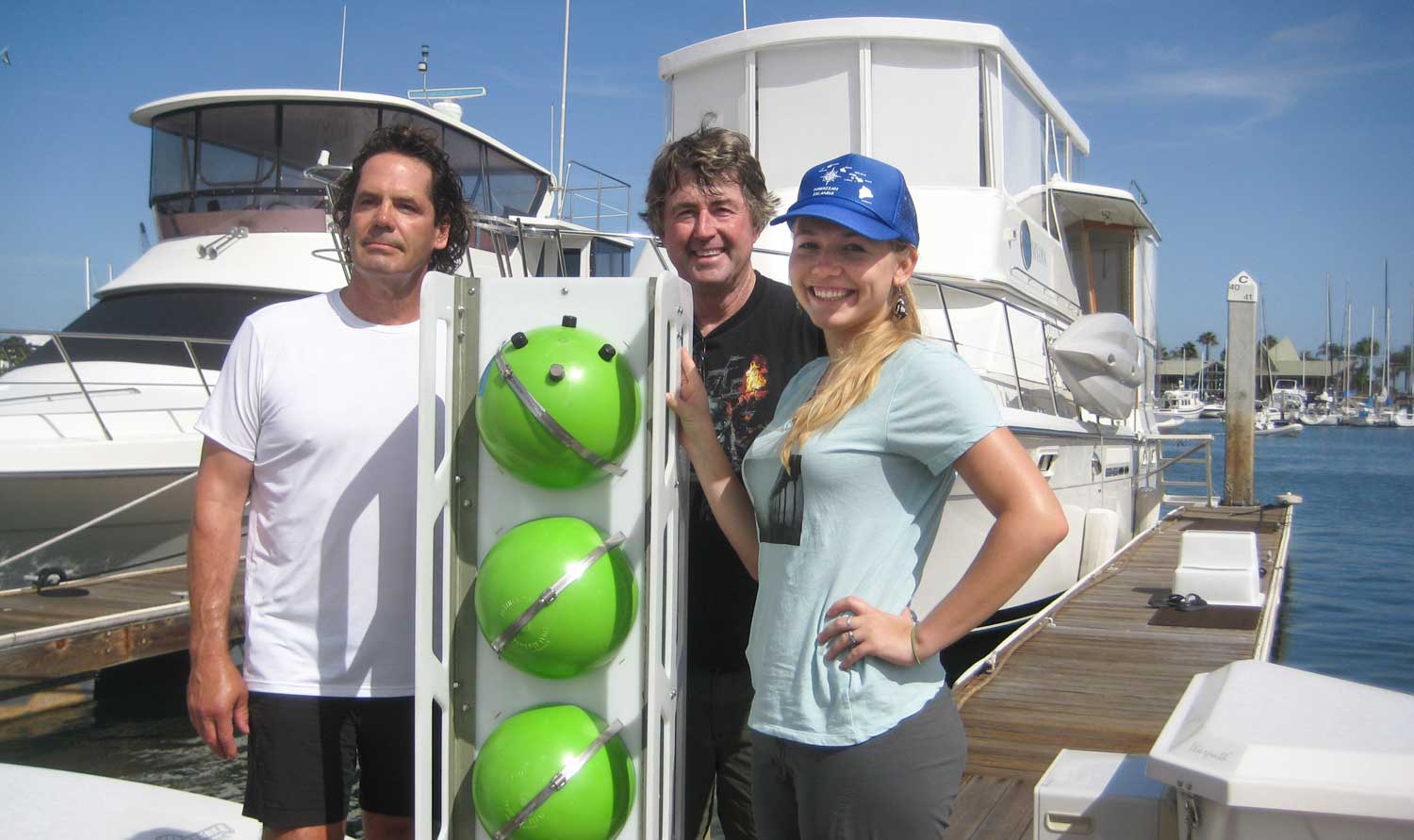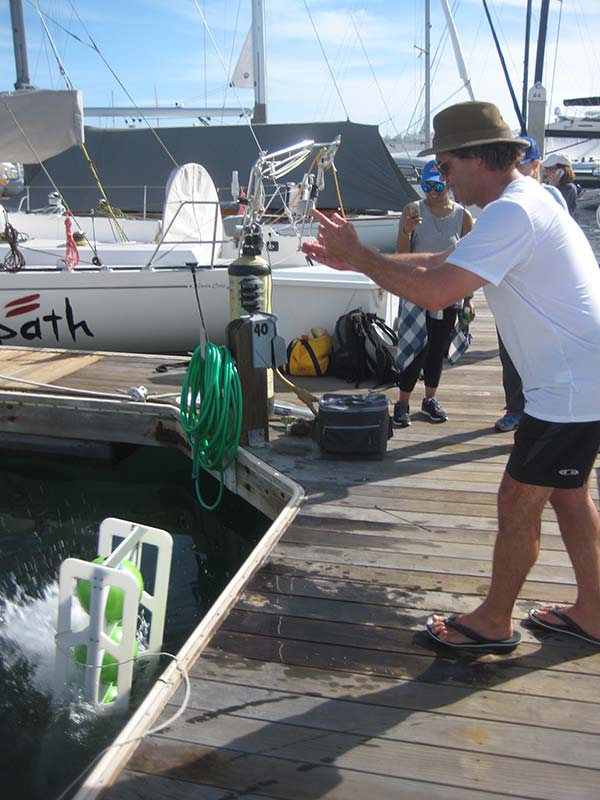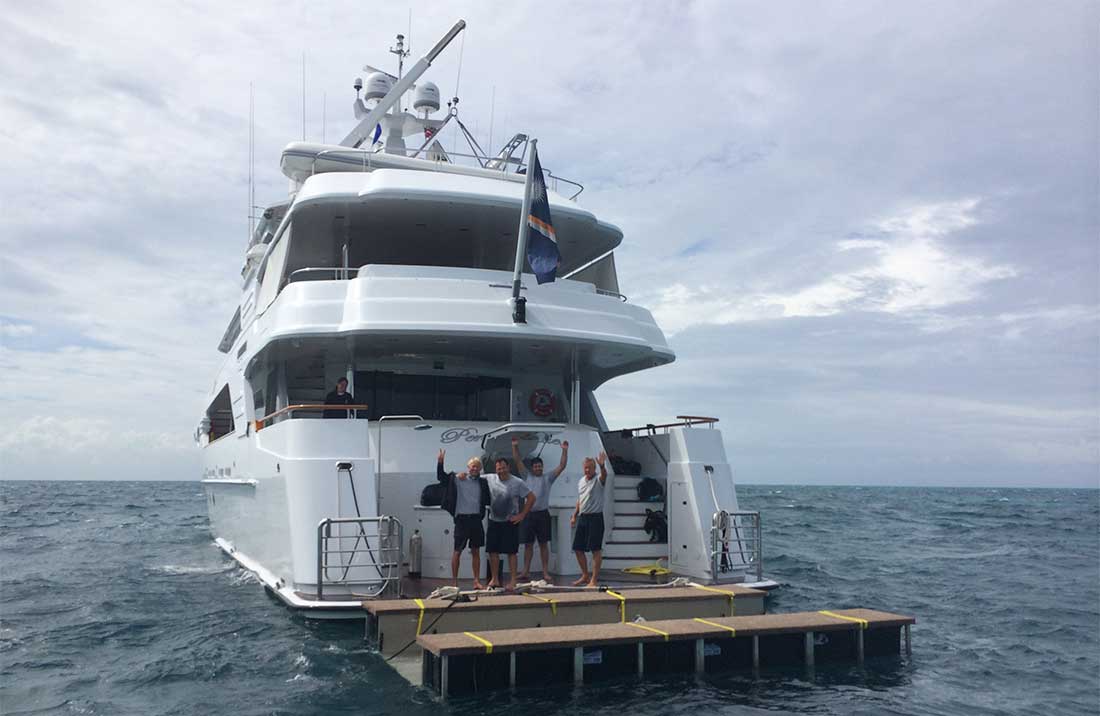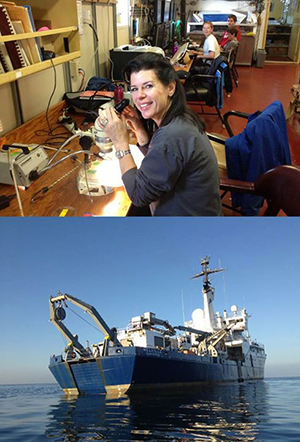
By:
- Mario C. Aguilera
Published Date
By:
- Mario C. Aguilera
Share This:

Rodney Moll (left), owner and master of the yacht Niyama (background), with Kevin Hardy, Scripps retired engineer, Natalya Gallo, a Scripps graduate student, and a "nanolander" developed to deploy deep-sea instruments.
Citizen Scientists Dive in to Support Scripps Exploration on the High Seas
Collaboration with SeaKeepers leverages yachting vessels as platforms for science
Scripps Institution of Oceanography’s fleet of research vessels, soon to be augmented with the arrival of the new R/V Sally Ride, has logged hundreds of thousands of nautical miles exploring the world’s oceans—over undersea volcanoes and through monstrous waves—seeking answers to some of the planet’s most daunting environmental challenges.
That effort has now risen to a new level. An agreement signed between Scripps and the International SeaKeepers Society (SeaKeepers) will leverage the might of citizen scientists in support of research projects at sea.
The heart of the agreement calls for SeaKeepers—a yachting society with a mission to promote oceanographic research, conservation, and education—to tap into its database of yachting vessel owners willing to offer their ships to marine research and exploration. When a need arises from a Scripps scientist, engineer, or student, a match will be made and the researcher will have a new opportunity to collect samples, deploy instruments, and further their science.

Rodney Moll, owner and master of the yacht Niyama, deploys a "nanolander" at the San Diego Yacht Club dock.
“This agreement provides a way for citizens—yacht owners—to participate in scientific research in a meaningful way,” said Bruce Appelgate, associate director of Scripps Oceanography and head of the institution’s Ship Operations and Marine Technical Support. “It affords the opportunity for interested and motivated nonscientists to make real connections with scientists and their institutions, and to make tangible contributions to ocean science. Through this program, scientists and nonscientists alike can share the experience of understanding and protecting the planet.”
The roots of the collaboration were planted in 2011 when Scripps Director’s Council member Patty Elkus, a founding member of SeaKeepers, worked with Kevin Hardy, a longtime Scripps engineer now retired, on ways to match SeaKeepers member vessels with projects that could benefit from ship support. The idea was guided by Angela Rosenberg, SeaKeepers director of programs and policies, and the SeaKeepers Discovery Yachts Program was born to support science and education outreach.
For Scripps, the newly signed agreement formally opens broad avenues of research with dozens of ships around the world willing to take science to sea. For members of the yachting world, the program allows ship owners to contribute to cutting-edge science in areas spanning from marine biology to climate change science.
“My motivation was to connect two exemplary ocean organizations that I support, and align them into a synergistic relationship that will advance oceanographic science,” said Elkus. “As a citizen scientist, I understand firsthand that the Discovery Yachts program is a valuable platform for providing our Scripps scientists with crucial ocean access. It introduces them to SeaKeepers citizen scientists who have the interest and means to support their work in a tangible way and are interested in ‘daring exploration.’”

The yacht Penny Mae was used for a shark tagging research project as part of the SeaKeepers Discovery Yachts Program. Photo by International SeaKeepers Society
In an early demonstration proving the value of such collaborations, Scripps graduate student Natalya Gallo is advancing her research on the ecology of deep-sea organisms with help from the San Diego Yacht Club and a local yacht owner.
Gallo is investigating the impact of declining subsurface oxygen levels off California, which are known to have dropped some 20-30 percent over the last 25 years. She is looking to deploy oxygen-measuring devices in Southern California’s deep-sea environments in an effort to evaluate how frequently nearshore deep-sea areas are exposed to low-oxygen conditions and how fish respond to such changes.
Gallo had previously worked with Hardy and his extensive expertise in deploying and recovering instruments in the harsh and highly pressurized conditions of the deep. Hardy developed 14-foot-tall deep-sea “lander” science instruments as part of ocean explorer and filmmaker James Cameron’s record-breaking dives to the deepest points on Earth.
Following the successes of the Cameron missions, Hardy developed miniature landers capable of being hand-launched off yachting vessels. San Diego Yacht Club’s Rodney Moll learned of Gallo’s research and Hardy’s new 5-foot-tall “nanolander” and volunteered to take them to sea aboard his vessel Niyama. (In the tradition of famed Scripps geophysicist and oceanographer Walter Munk’s research groups, each instrument is given a name. Gallo has named her nanolander “Beebe” after 1930s deep-sea explorer William Beebe).
In the spring, Moll’s ship will deploy a nanolander equipped with Gallo’s oxygen sensor package and camera system in the Scripps Coastal Reserve off La Jolla. The nanolander and sensor package are capable of recording data unattended on the seafloor in water as deep as 6,500 feet, although this study will focus on depths between 300 and 1,200 feet. Months later, the nanolander and scientific instruments filled with new data will be recalled to the surface via an acoustic signal and retrieved.

Citizen scientist Patty Elkus (top) aboard Scripps Research Vessel Melville during the San Diego Coastal Expedition.
“Regular access to the sea makes this research possible, but the partnership with the SeaKeepers Discovery Yachts Program is also a unique opportunity for scientists to engage with the greater community,” said Gallo. “By partnering yacht owners with young scientists, we can both advance scientific efforts and actively engage interested members of the public in the scientific process.”
For Hardy, an expert in Scripps’s history of exploration, the agreement is a throwback to the institution’s earliest days of research when scientists made full use of citizen scientists and their interests in helping the young institution in its fledgling scientific endeavors.
“More than a hundred years ago, Scripps’s first expeditions used private vessels operated for, or loaned to, the institution by (Scripps co-founder) E.W. Scripps and his colleagues,” said Hardy.
Charles Scripps, great-grandson of E.W. Scripps, was briefed on the collaboration with the yachting community and is excited at its prospects.
“Scripps and SeaKeepers know that when the cost of getting to sea is dramatically reduced, along with the risk associated with reaching the seafloor, then scientific hunches and technical novelty that stretch today’s methods can be tested, evaluated, and improved,” said Hardy. “New breakthroughs will certainly follow.”
Gallo’s research has been supported by the Michael M. Mullin Fellowship at Scripps and the Mildred E. Mathias Graduate Student Research Grant; She also is supported by the National Science Foundation Graduate Research Fellowship Program.
Share This:
Stay in the Know
Keep up with all the latest from UC San Diego. Subscribe to the newsletter today.


